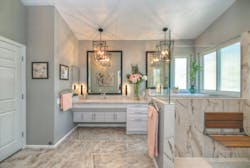Contrary to predictions, sales of aging-in-place projects have slowed down during the pandemic as older clients worry about catching the virus. Still, aging-in-place design is a huge opportunity. I predict once older homeowners feel safe, there will be a huge influx in remodeling requests. Here are a few guidelines to talking about the topic.
1. Lead with the science
Since I am trained in how the body ages and how to design for it, I can talk through some of the things that clients can expect to happen. Not everybody ages the same way, but there are certain predictable outcomes. Nobody thinks they’re going to fall, but the reality is that even in our 50s, we start losing balance. The best thing an older adult can do is prepare for preventing falls and accidents.
2. Emphasize independence
Instead of being salesy, it’s about being sensitive and putting yourself in their shoes. I try to downplay that they’re aging, but let them know their bodies are changing and you just need to accommodate those changes. I relate stories of other clients or even my own dad.
3. Be prepared to work with family members
I worked with one lady who had Alzheimer’s, but could still communicate. Her nephew and I handled the floor plans, but when it came to finishes and fixtures, I showed her what I selected to keep her involved. After the meeting, I would let him know her feedback, since she wouldn’t remember it later.
4. Get clients to see the big picture
Sometimes when older people have an incident—a fall, maybe—the reaction is, “Oh, I just need to get grab bars.” But there’s much more to keeping older adults independent. Clients may end up needing a caregiver, and this will require designing rooms to account for the other person, meaning the spaces will need to be that much bigger.
5. Don’t fake it
If you fake it, you’re going to risk the health of your clients and your business. My recommendation to get started is to get credentials like NAHB’s Certified-Aging-in-Place (CAPS) program; learn about ADA guidelines; and if you aren’t sure about something, bring in a dedicated aging-in-place design specialist. Seniors’ psychological, emotional, and physical wellness comes first.
Bonnie J. Lewis is the principal of 55+ TLC Interior Design, LLC. She is an NAHB Certified Aging in Place Specialist and 2020 winner of the Best Overall CAPS category from NAHB Remodelers.
